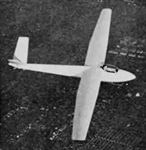
M.Hardy. Gliders & Sailplanes of the world
Akaflieg Braunschweig SB-5C Danzig
The Akaflieg, or Akademische Fliegergruppe, of Brunswick (Braunschweig) University has designed and built a series of high performance sailplanes, the SB-5 Danzig being a Standard Class (15m span) single-seater which first flew in prototype form on 3 June, 1959. Licence production was undertaken by Firma Eichelsdorfer at Bemberg, and over 100 SB-5s of all variants were built. The SB-5C, which first flew in 1965, incorporated several design changes. The SB-5E, which entered production in 1974, had the wing span increased to 16m (52ft 6in) to comply with Club Class regulations. SB-5B or SB-5C Danzigs can be modified up to SB-5E standard. The type is of conventional all-wood construction, with a single-spar shoulder wing with plywood covering and a butterfly tail; Schempp-Hirth air brakes are situated at the 50% chord line. The landing gear is a non-retractable unsprung monowheel with a friction brake, and there is also a tailskid. The plywood monocoque fuselage has an outer coating of glassfibre.
Data: SB-5C
Span: 49 ft 2 1/2 in
Length overall: 21 ft 10 in
Wing area: 140 sqft
Aspect ratio: 17.3
Empty weight: 485 lb equipped
Max take-off weight: 716 lb
Max speed: 124 mph (in smooth air)
Min sinking speed: 2.07 ft/sec at 41 mph
Best glide ratio: 32.5:1 at 48 mph
Akaflieg Braunschweig SB-7 Nimbus FGR
The SB-7 Nimbus is a development of the Akaflieg Braunschweig SB-6 Nixope, an ultra high aspect ratio high-performance single-seater with an 18m (59ft 0in) span wing, an aspect ratio of 25 and a best glide ratio of 42:1. The SB-6, which made extensive use of glassfibre in its structure, first flew on 2 February 1961 but was destroyed in August 1964. The SB-7 Nimbus, which first flew in October 1962, featured a 15m (49ft 2 1/2in) span wing for Standard Class requirements with a lower aspect ratio, and a T-tail instead of the SB-6's lower-mounted tailplane. Like the SB-6, the SB-7's shoulder wing has a box spar with glassfibre flanges and is covered with diagonally-laid glassfibre skin stabilised with balsa; the ailerons are of wooden construction and there are two Schempp-Hirth air brakes on each side at the 75% chord line. The fuselage, again like the SB-6's, is a glassfibre monocoque stabilised with balsa. The tail unit is of similar construction to the wing, with the one-piece all-moving tailplane on top of the fin. Landing gear is a retractable monowheel with friction brake and there is also a tailskid. In Switzerland an SB-7 was modified by Paul Kummer and Oskar Wiesendanger of Zurich to have a completely new wing of increased span (54ft 2 1/2 in) and aspect ratio (20.85) and with an Eppler 417 aerofoil section; trailing edge air brakes replaced the Schempp-Hirth ones of the standard SB-7 and a tail-braking parachute was fitted. The first of two prototypes of this modified SB-7 made its maiden flight on 20 May 1967, and two more prototypes were built.
Data: SB-7
Span: 49 ft 2 1/2 in
Length overall: 22 ft 11 1/2 in
Height over cockpit: 2 ft 5 in
Wing area: 127.6 sqft
Aspect ratio: 19
Empty weight: 562 lb equipped
Max take-off weight: 794 lb
Max speed: 158 mph (in smooth air)
Min sinking speed: 2.20 ft/sec at 56 mph
Best glide ratio: 37.5:1 at 56 mph
Akaflieg Braunschweig SB-9 Stratus
The SB-9 Stratus high-performance single-seater was developed by Akaflieg Braunschweig from the 18m (59ft 0in) span SB-8, and first flew in prototype form on 23 January 1969, making its debut at the German National championships that year. The SB-9 featured a higher aspect ratio (31.3) wing of 22m (72ft 2 1/4 in) span, this giving a best glide ratio of 48:1 compared to 42:1 for the SB-8, a lower minimum sinking speed and otherwise improved performance. But some problems were encountered with the wing geometry, especially aileron length, load distribution over the wing and rudder action, and as a result the maximum speed had to be limited to only 107mph. Later, wing span was reduced to 21m (68ft 11 in), this giving an improvement of 12 mph in the maximum speed. The SB-9's wing is of PVC foam construction for lightness, and has a glassfibre roving spar; the HKS type flaps are of elastic glassfibre construction with no hinge or gap. The fuselage is of glassfibre construction with balsa wood support, and the landing gear is an unsprung retractable monowheel with a drum-type brake. A T-tail is featured, the tail unit being of glassfibre and balsa construction.
Data: SB-9
Span: 72 ft 2 1/4 in
Length: 24 ft 7 1/4 in
Height: 4 ft 7 in
Wing area: 166.6 sqft
Aspect ratio: 31.3
Empty weight: 692 lb
Max weight: 917 lb
Max speed: 107 mph
Min sinking speed: 1.5 ft/sec at 45 mph
Best glide ratio: 48:1 at 53 mph
- M.Hardy. Gliders & Sailplanes of the world
Фотографии
-
Jane's All the World Aircraft 1964 / 03 - Sailplanes
Akaflieg Braunschweig SB-5
-
Jane's All the World Aircraft 1972 / 03 - Sailplanes
Akaflieg Braunschweig SB-5c single-seat high-performance sailplane
-
Jane's All the World Aircraft 1974 / 03 - Sailplanes
Akaflieg Braunschweig SB-5c Danzig single-seat high-performance sailplane
-
Jane's All the World Aircraft 1972 / 03 - Sailplanes
Akaflieg Braunschweig SB-7B Nimbus single-seat Standard Class sailplane
-
Jane's All the World Aircraft 1966 / 05 - Sailplanes
Akaflieg Braunschweig SB-7 single-seat Standard Class sailplane
-
Jane's All the World Aircraft 1964 / 03 - Sailplanes
Akaflieg Braunschweig SB-7 single-seat high-performance sailplane
-
GL 1982- / M.Hardy - Gliders and Sailplanes /Gliders & Sailplanes of the world/ (1)
Akaflieg Braunschweig SB-7 Nimbus.
-
GL 1982- / M.Hardy - Gliders and Sailplanes /Gliders & Sailplanes of the world/ (1)
Регистрационный номер: D-6085 Akaflieg Braunschweig SB-9 Stratus.
-
Jane's All the World Aircraft 1972 / 03 - Sailplanes
Akaflieg Braunschweig SB-9 Stratus single-seat high-performance sailplane
- Фотографии








